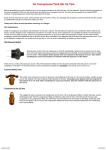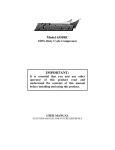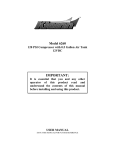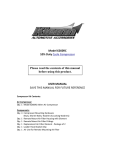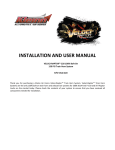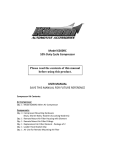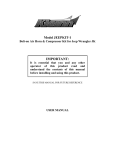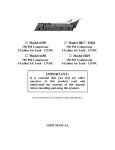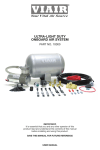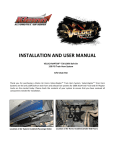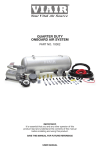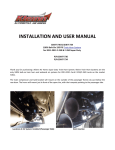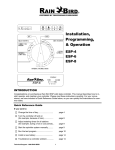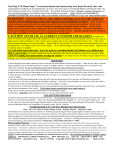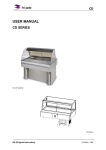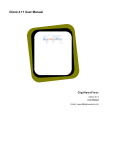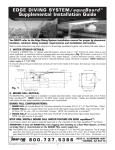Download Installation Instruction
Transcript
Model 6275 1500 PSI Compressor with 11.5-Gallon Gallon Air Tank 12VDC IMPORTANT: It is essential that you y and any other operator of this product read and understand the contents of this manual before installing and using this product. SAVE THIS MANUAL FOR FUTURE REFERENCE USER MANUAL Model 6275 Components: 1 1 1 1 1.5 Gallon, 5-port air tank Model 6275RC compressor Package air fittings Package mounting hardware (Please check to make sure that you have two packages in your kit. Each package contains the parts needed for specific areas of onboard air installation, and may contain smaller bags within each package labeled for specific use.) PARTS PACKAGES Package #1 – Compressor Installation Qty 1 1/8” NPT Pressure Switch (110 PSI on, 145 PSI off) Qty 1 1/4” NPT 170 PSI Safety Valve Qty 1 1/4”M x 1/8”F Hex Reducer Qty 1 1/4” NPT Drain Cock Qty 1 1/4” NPT Compression Fitting Package #2 – Compressor Installation Qty 4 13/64” Nuts, shorter bolts, washers & locking washers (Compressor mounting hardware) Qty 1 Remote Mount Air Filter Assembly Qty 1 Remote mount air filter fitting for air filter connection Qty 1 Replacement air filters Qty 1 Leader Hose Bracket Clip Qty 1 Air line for remote mounting air filter Qty 2 Nuts, bolts, and washers – (Air tank mounting hardware) 1.5 Gallon Air Tank Installation Your 1.5 Gallon air tank comes with five 1/4” NPT port openings to allow a variety of installation configurations in your vehicle. To insure safe and trouble-free use of your air tank, we strongly recommend that you install the supplied drain cock and a safety pressure relief valve. (Use contents of Package # 1 for this installation step). IMPORTANT: • Tank is rated for 150 PSI maximum working pressure. • Tank is not to be used as a breathing device. • Bleed pressure from tank before servicing or adding attachments. • Use only attachments or tools rated for 150 PSI working pressure or less. CAUTION! DO NOT PRESSURIZE YOUR TANK UNTIL YOU HAVE INSTALLED ALL NECESSARY PORT FITTINGS AND ACCESSORIES. • Apply sealant or Teflon tape to threads of fittings prior to assembly and tighten each part with a wrench. • Do not over tighten, since brass threads can be stripped. • Always release air from tank before servicing. WARNING: FAILURE TO DRAIN TANK AND REMOVE CONDENSATION WILL CAUSE TANK TO RUST PREMATURELY. • To remove accumulated condensation inside the tank, use the drain cock to bleed pressure from tank until pressure is approximately 5 PSI to 20 PSI. • Drain water from tank by opening the drain cock drain valve and close after draining tank. • If drain cock valve is plugged, release all air pressure from tank, remove drain valve and clean, then reinstall. IMPORTANT: The drain cock should be installed at the bottom of the tank. The ports on the tank are configured so that whether the tank is installed upright, upside-down or sideways, there is always a port on the bottom. PLEASE NOTE: RUSTED TANKS CAN FAIL CAUSING EXPLOSIONS OR FATAL INJURIES. Discard tank immediately if tank is rusted. When using a safety pressure relief valve, point the safety pressure relief valve away from your body when releasing air. Use the pull ring on the safety relief valve; open the relief valve to vent any pressure inside the tank before servicing tank. Tank Fittings: Install the supplied compression fittings and/or quick connect fitting for the air tank in areas where they are most appropriate for your installation using thread sealant or Teflon tape. Make sure that the safety valve is installed in the top most position on the tank, and that the drain cock is installed in the lowest position on the tank if the tank is to be installed in any other position than upright on the tank’s mounting legs. Be sure that all fittings are accessible later in the installation process since you will have to plumb air lines to each fitting as needed to utilize the air tank. 6275 Air Compressor Installation Your system comes complete with a model 6275, 25% duty cycle compressor. Please follow the installation instructions that follow to enjoy the best use of your onboard air system. (Use contents of Package # 2 for this installation step) CAUTION - To reduce risk of electrical shock or electrocution: • Do not disassemble the compressor. Do not attempt repairs or modifications. Refer to qualified service agencies for all service and repairs. • Do not use this product in an area where it can fall or be pulled into water or liquids. • Do not reach for this product if it has fallen into liquid. • Use this compressor with 12-volt DC systems only. • This product should never be left unattended during use. Guidelines for Selecting Mounting Location: The selection of proper mounting location for your air compressor will help ensure a long and trouble free compressor service life. Please pay close attention to the following: • • • • Select a flat and secure location where the compressor can be mounted. The 6275 can be mounted in any position, however, we do not recommend mounting it upside down, as this can cause excessive heat build-up. To maximize air compressor performance, locate compressor as close to the battery as possible so that length of positive lead wire required is at a minimum. Choose mounting location that is as cool as possible and away from heat sources. This compressor is moisture & dust resistant, but NOT WATERPROOF or DUST PROOF. Do not mount compressor in locations such as behind a tire, where the unit is likely to come in contact with excessive water or dirt. The 6275 may be mounted underneath your vehicle as long as you use the remote air intake kit that is included with the system and relocate the air intake. When using the remote intake, select compressor’s mounting location where air line can be routed from compressor air • • inlet to remote inlet air filter. Make sure that the remote inlet air filter is located in a dry location, away from water. You will also want to select a compressor mounting location where the leader hose bracket can be mounted to secure the 2 ft. leader hose. If it is necessary to mount the air compressor further from the battery, such as inside your vehicle or in the bed of your pickup, use a minimum 10 AWG positive lead wire for remote installation. Do not mount compressor near areas where flammable liquids are stored. Compressor Wiring: 1. Disconnect ground cable from vehicle’s battery. 2. Temporarily position the air compressor in the location where it will be mounted. 3. Route ground wire to the negative post of the battery or to an appropriate grounding point and cut ground wire to length as needed. 4. Mount the air compressor with the four sets of 13/64” (5 mm) bolts, nuts, washers, and locking washers provided. Use of thread locker is recommended. 5. NOTE: For Remote Inlet Air Filter Installation, refer to Remote Inlet Air Filter Installation Instruction included in the Remote Inlet Air Filter Pack. 6. This air compressor comes with a heavy duty heat resistant stainless steel braided leader hose with ¼” fittings. This leader hose is designed to prolong the life of your air line. Do not remove this leader hose from air compressor. 7. IMPORTANT: Please note; the leader hose that came with your compressor has a built-in inline check valve. Do not remove inline check valve from leader hose. 8. Select a proper location to mount leader hose with hose bracket provided. Avoid locations where leader hose may become tangled with wires and other hoses. 9. To mount hose bracket, drill holes with 3/16” drill bit and push self–anchoring hose bracket pin into hole. Route leader hose through hose bracket and secure hose by pressing bracket clamp into locked position. 10. To remove hose from the hose bracket, simply press down on the hose clamp release tab to release bracket clamp. 11. Connect compressor’s positive lead wire to one of the leads of your pressure switch. 12. Make sure that your compressor setup is properly fused. The compressor pulls approximately 14 maximum amps of power. 13. Always locate fuse as close as possible to power source. 14. Before connecting to power source, check to make sure that all connections are made properly. 15. Connect and test compressor system by running the compressor for a short time to build up pressure in your air tank. 16. Once air pressure reaches the preset cut out pressure of your pressure switch, the compressor will shut off. Inspect all air line connections for leaks with soap and water solution. If a leak is detected, the air line may not be cut squarely or pushed all the way in. Tighten connections if needed. 17. Always use a “switched” power source that only supplies power to your compressor when the vehicle is running. COMPRESSOR OPERATING INSTRUCTIONS IMPORTANT: The compressor has a maximum working pressure of 150 PSI and is capable of 25% duty cycle. It is designed for use with air horns, air bags and other accessories that utilize the compressed air stored in the tank. It is not designed for continuous use applications such as tire inflation or air tools. Always operate the compressor at or below the MAXIMUM PRESSURE RATING of the compressor. Operation exceeding maximum pressure ratings and or duty cycle will result in damage to air compressor. 1. Your air compressor is equipped with an AUTOMATIC THERMAL OVERLOAD PROTECTOR. This feature is designed to protect the air compressor from overheating and causing permanent damage to your air compressor. The thermal overload protector will automatically cut off power to your air compressor should the internal operating temperature of the air compressor rise above safe levels during excessive use. 2. Should your air compressor automatically shut off while in use; do not attempt to restart the air compressor. Turn power switch to the air compressor to the OFF position. The automatic thermal overload protector will automatically reset when internal temperature of the air compressor drops below safe level. After allowing air compressor to cool off for about 30 minutes, you can safely resume use of the air compressor by turning on the air compressor. 3. To prevent discharge of your vehicle’s battery and to provide peak performance, we strongly recommend that you keep the vehicle’s engine running while using the air compressor. 4. ONLY OPERATE THE AIR COMPRESSOR IN WELL-VENTILATED AREAS. Compressor Maintenance & Repairs 1. Periodically check all electrical and fitting connections. Clean and tighten as needed. 2. Periodically check all mounting screws. Tighten as needed. 3. Replace air filter element periodically. Replacement frequency depends on operating frequency and operating environment. For frequent use in dusty environment, you should replace air filter element more often. 4. Regularly clean dust and dirt from compressor. 5. Your air compressor is equipped with permanently lubricated, maintenance free motor. Never lubricate compressor. 6. Repairs should be performed by Manufacturer or Manufacturer’s Authorized Service Agencies only. CAUTION: Never touch the air compressor or fittings connected to the air compressor with bare hands during or immediately after use. Leader hose and fittings will become very HOT during and after use. Compressor Installation Tips 1. Always use the remote intake filter option when possible. This will extend the service life of your compressor. 2. If noise reduction from vibration is desired, using the remote mount option for the inlet filter can reduce operation noise by up to 25%. 3. Always mount the compressor at a point higher than the inlet port of the tank. This will keep moisture from being able to seep back to the tank. 4. When mounting the compressor, use a paint pen on the rubber isolators and cover the side to go against the chassis or mounting location. Then, simply stamp the compressor against the chassis to make an imprint of exactly where to drill the mounting holes for the compressor. Pressure Switch Installation Your system comes complete with a pressure switch that will turn on the compressor at 110 PSI, and off at 145 PSI. The pressure switch has a 1/8” NPT inlet at the bottom that will need to be threaded into the supplied T-fitting (using thread sealant) to allow it to be plumbed directly to your air tank. (Use contents of Package # 1 for this installation step) Pressure Switch Installation Tips 1. Never install a pressure switch in direct line from the inlet port coming from the compressor. Tank pressure can be misread by the pressure switch. Instead, mount the pressure switch on the tank where it receives readings from deflected air in the tank. 2. Never use a pressure switch that is rated beyond your compressor’s rated Maximum Working Pressure (150 PSI). 3. For best performance and maximum life, use the Kleinn 6850 installation kit to connect your pressure switch to your power source. Testing Your System Your system installation is now complete. Run the compressor to build pressure in the air tank. When air pressure reaches the pressure switch cut out pressure, the compressor will shut off. Inspect all air line connections for leaks by spraying a soap and water solution If leaks are detected, re-attach hoses or apply Teflon thread tape as needed. Periodically check your system’s fitting in this manner should your compressor turn on more often than normal without frequent air use. Air Tank Layout Note: Your setup may look different if your tank is mounted in a position other than what is shown above. Follow these guidelines for proper setup: • Drain cock should always be on the bottom • Safety valve should always be on the top • Pressure switch should be on the side, but not directly opposite the inlet from the compressor Kleinn Model 6275 LIMITED WARRANTY Kleinn Automotive Air Horns warrants this product, when properly installed and under normal conditions of use, to be free from defects in workmanship and materials for a period of one year from provided date of purchase. To receive a replacement or for repairs, airs, return the complete unit to retailer from whom it was purchased along with proof of purchase. Returns should be made within the time period and conditions of the retailer’s policy for exchanges. If you are unable to contact your dealer, contact Kleinn directly for repairs or replacement at our option. Kleinn Automotive Accessories P.O. Box 91278 Tucson, AZ 85752 Phone: (520) 579-1531 Fax: (520) 579-1528 [email protected]









